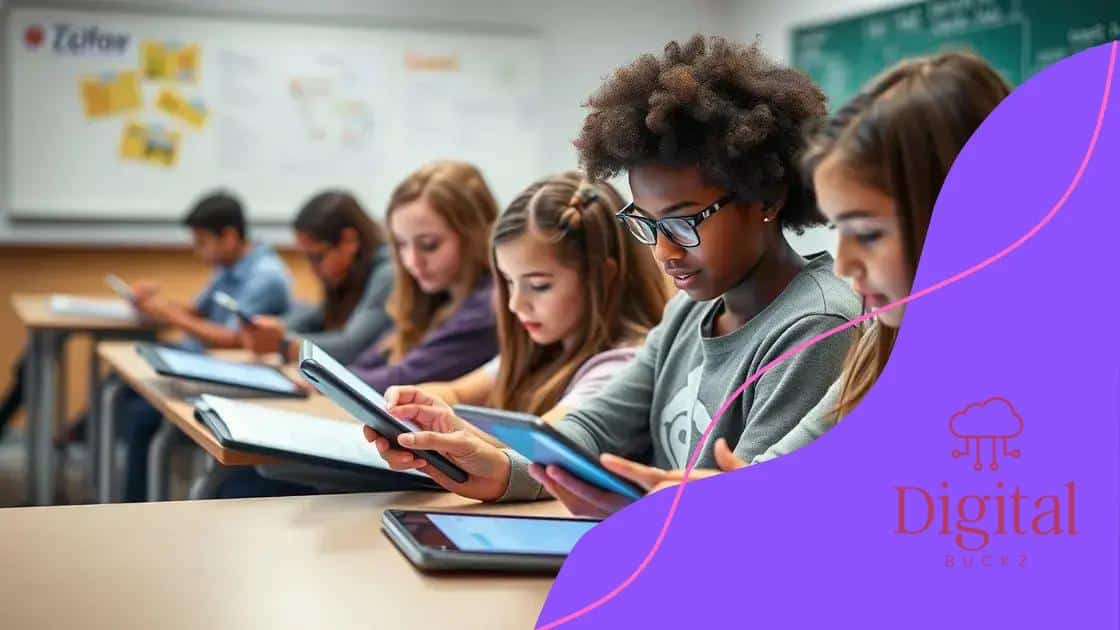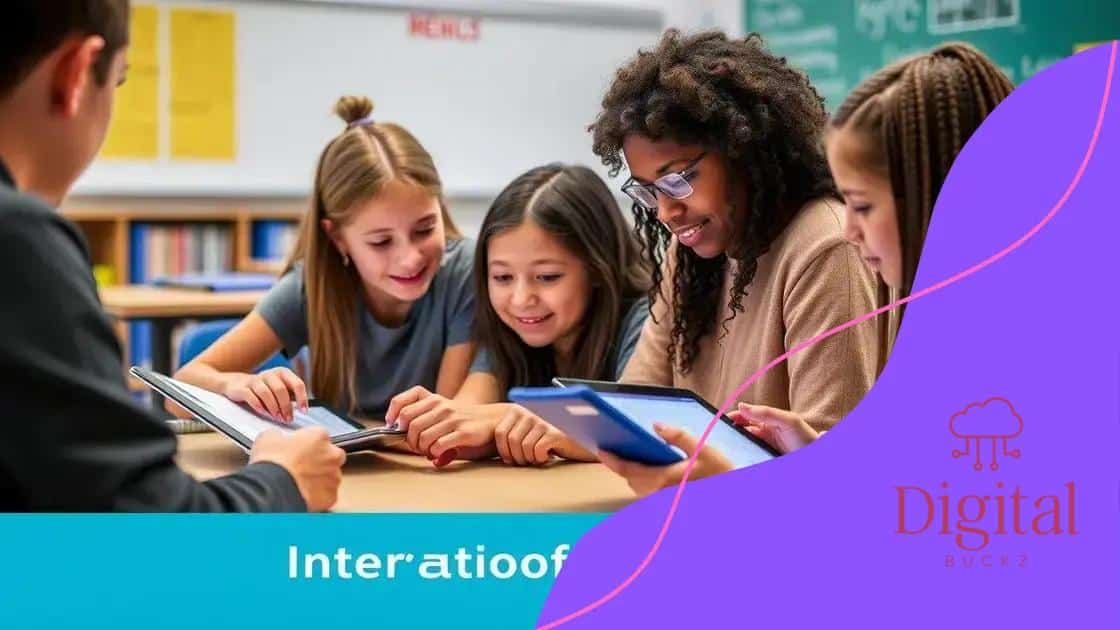Trends in digital textbooks replacing traditional ones

Trends in digital textbooks replacing traditional ones signify a transformative shift in education, providing cost savings, enhanced engagement through interactivity, and personalized learning experiences while addressing challenges like technology access and screen fatigue.
Trends in digital textbooks replacing traditional ones are reshaping the educational landscape. Have you noticed how classrooms are evolving? Let’s dive into this exciting transformation.
Introduction to digital textbooks
The shift to digital textbooks marks an important evolution in education today. Many students now carry a library in their pocket, ready at a moment’s notice.
What Are Digital Textbooks?
Digital textbooks are electronic versions of traditional textbooks. They often come with interactive features that enhance the learning experience. Students can access their materials on various devices, making studying more convenient.
Benefits of Digital Textbooks
- Cost-effective compared to printed editions.
- Access to up-to-date information and resources.
- Interactive features such as quizzes and videos.
This convenience is one of the key reasons why digital textbooks are gaining popularity. Imagine not having to lug around heavy books, as everything you need is just a click away.
Another advantage is the ability to easily search through content. Instead of flipping through pages, students can quickly find what they need. This feature saves time and allows for better study habits.
Challenges with Digital Textbooks
However, there are challenges as well. Many students struggle with screen fatigue when reading long texts. To counter this, some prefer balancing digital textbooks with physical copies.
In addition, internet access can be a barrier for some students. Reliable connectivity is essential for accessing digital materials anytime, anywhere. Schools and educators must work to ensure all students can benefit from these modern tools.
Despite these challenges, the introduction of digital textbooks is paving the way for a more engaging and inclusive learning environment. Educators are exploring new methods to integrate these technologies into the classroom effectively, adapting to meet the needs of all learners.
Advantages of digital over traditional textbooks
Digital textbooks offer numerous advantages compared to traditional printed ones. For today’s students, having access to digital textbooks can greatly enhance their learning experience.
Cost Savings
Digital textbooks are often more affordable than their printed counterparts. This makes education more accessible for many students. When schools adopt digital formats, they can save money, too.
Accessibility and Convenience
- Students can read anywhere, anytime, as long as they have their device.
- Features like font resizing and text-to-speech make materials easier to use.
- Quick updates ensure all students have the latest information.
With traditional textbooks, students must carry heavy books to school. This can be burdensome, especially when they have multiple classes. Digital formats eliminate this issue, allowing students to keep all their materials on a single device.
Another perk is the availability of interactive content. Many digital textbooks come equipped with videos, quizzes, and animations. These interactive elements can help students engage with the material more deeply and retain information better.
Environmentally Friendly
Using digital textbooks also benefits the environment. Fewer printed books mean less paper waste. Schools can contribute to sustainability efforts by adopting digital solutions, which aligns with current eco-friendly trends.
Overall, the shift towards digital textbooks represents a modern approach to education, making learning more dynamic and resourceful. Schools and teachers can leverage these benefits to create better educational experiences for their students.
Impact on student learning outcomes

The impact of digital textbooks on student learning outcomes is significant. These resources have the potential to enhance how students engage with their studies.
Improved Engagement
With interactive features, digital textbooks can capture students’ attention more effectively than traditional books. Students can take quizzes, watch videos, and participate in activities that make learning more engaging.
Personalized Learning
- Students can learn at their own pace.
- Customization options allow for tailored experiences.
- Diverse media formats can cater to different learning styles.
This flexibility helps students grasp difficult concepts more easily, leading to better retention of information. When students can interact with content that suits their learning preferences, their understanding deepens.
In addition, the ability to quickly search for information makes studying more efficient. Instead of flipping through pages, students can find what they need in seconds. This instant access fosters a more productive study environment.
Collaborative Learning Opportunities
Digital textbooks also encourage collaboration among students. Many platforms allow students to share notes and insights. This collaboration enhances their learning experience by letting them learn from each other.
The overall impact of digital textbooks on student learning outcomes is clear. Embracing these resources can create a more effective, engaging, and personalized learning environment, which benefits both students and educators alike.
Challenges of adopting digital textbooks
Adopting digital textbooks comes with its own set of challenges. While the benefits are appealing, many schools and students face difficulties during this transition.
Access to Technology
One major challenge is ensuring all students have access to the required technology. Not every student owns a tablet or laptop. In some areas, lack of internet connectivity hinders usage.
Screen Fatigue
- Some students find reading on screens tiring.
- Extended screen time can lead to discomfort.
- Teachers need to consider balancing digital and print resources.
This screen fatigue can negatively affect learning. Thus, it becomes essential to provide alternatives so that students can still access content without overexposure to screens.
Another difficulty is the need for training. Both students and teachers must learn how to efficiently use digital textbooks. Without proper training, users can feel overwhelmed or frustrated when navigating these platforms.
Content Updates
Keeping content current is also a challenge. While digital textbooks can be updated easily, some schools struggle to stay on top of these updates. When instructors don’t use the latest materials, students may miss out on important information.
Overall, while the shift to digital textbooks holds great potential, addressing these challenges requires thoughtful planning and support from schools, educators, and families. Ensuring all students have equal access and the necessary resources is vital for a successful transition.
Future outlook for digital education
The future outlook for digital education appears promising, with many innovations on the horizon. As technology continues to advance, it will impact how students learn and interact with educational materials.
Integration of Artificial Intelligence
Artificial intelligence (AI) is set to play a significant role in digital education. Personalized learning experiences can be enhanced through AI tools that adapt to individual student needs. This technology analyzes learning patterns and provides tailored recommendations.
Increased Interactivity
- Future digital textbooks will likely offer more interactive content.
- Quizzes, games, and simulations can improve student engagement.
- Collaboration tools will enhance group learning experiences.
By incorporating these interactive elements, students will find learning more enjoyable and effective. This shift away from passive reading will encourage active participation.
The expansion of online learning platforms also represents a significant trend. More students are turning to online resources for their education. This opens up opportunities for remote education, making learning accessible to students worldwide.
Focus on Lifelong Learning
As the world changes, so does the need for ongoing education. The future of digital education will emphasize lifelong learning. This means that individuals of all ages will have access to resources that help them develop new skills and knowledge throughout their lives.
As educators and technology companies work together, we can expect even greater advancements in digital education. These changes will not only enhance classroom experiences but also prepare students to succeed in a rapidly evolving world.
FAQ – Frequently Asked Questions About Digital Textbooks
What are digital textbooks?
Digital textbooks are electronic versions of traditional books, often enhanced with multimedia, interactive features, and real-time updates.
How do digital textbooks improve student engagement?
They offer interactive elements like quizzes and videos that make learning more enjoyable and help students retain information better.
What challenges do schools face when adopting digital textbooks?
Challenges include ensuring access to technology, screen fatigue among students, and the need for proper training for effective use.
What does the future of digital education look like?
The future includes enhanced personalization through AI, more interactive content, and a focus on lifelong learning opportunities for all ages.






